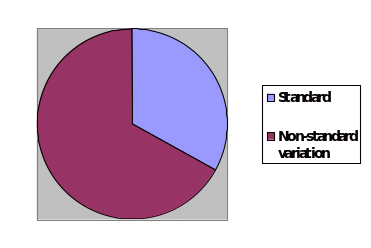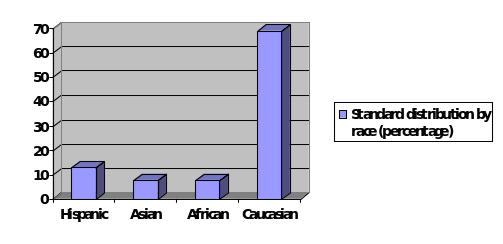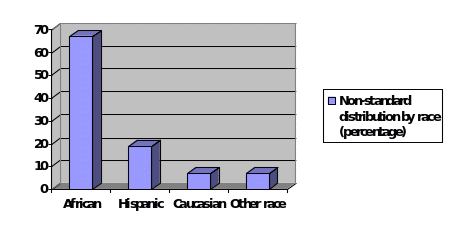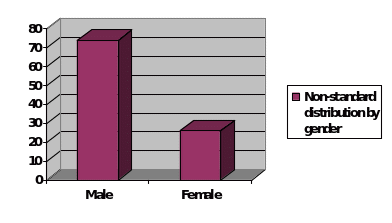Introduction: Aspect of Language Chosen for Variation
The following is a study of English variation in Carrollton, Georgia. In this area, there is much diversity, across age, race, and the use of linguistics. Slang is very common in this region and adds to the variations of English in the area. Meanwhile, however, this study was mindful not to consider the applications of slang as part of the English language and only considers it to be a cause of the variations rather than forms of English variation in itself. This means no consideration is given to slang words, while the emphasis remains on the combinations of words or omissions of words that seem to accompany the speaking patterns of those accustomed to using slang in their everyday language. The sociolinguistic theories as evident in Milroy and Gordon (2003), Stockwell (2002), and Wardhaugh (2006) are discussed as they relate to ESL explanations of variation and teaching ESL. Furthermore, Meyerhoff & Niedzielski (2003) have also integrated geographic areas into newer sociolinguistic theories.
The chosen phrase segment for this paper is “what are you” as is common in the phrases “What are you trying to do?”, “What are you doing?”, “What are you guys up to?” etc. The hypothesized variations of this segment were predicted as “what y’all,” “what you” (with the omission of ‘are,’) “what you be,” and other such variations. No percentages or statistical hypotheses had been made by the author in addition to these forms.
As the population in Carrolton, Georgia, is rich in African Americans, the prevalence of African American Vernacular Language or “ebonics” is high. This paper will give full consideration to this factor as it will add race as a factor in addition to age and gender while examining the phonological features and variations regarding the aforementioned phrase. The following analysis will examine the aspects of African American Vernacular Languages (AAVL) as it creates variability in the language, its prevalence in comparison to the entirety of the sample taken, an examination of patterns across the entirety of the chosen variables (age, sex, race,) a consideration of ESL literature’s explanation of variability in comparison to the study’s implications, and the implications of the overall findings as they apply to teaching ESL. While AAVL is commonly known, Dodsworth & Mallinson (2006) and Johnstone (2003) have been furthering the field by directly applying sociolinguistic theory to ethnic variations.
Research Methodology
The data for this study were collected at a local shopping center, to ensure proper diversity. The author considered unbalanced sampling from observing at the university because of the higher amount of educated individuals combined with the potentially uneven racial distribution. It is unknown if the university has an adequate representation of races and education versus ignorance has been proposed as a major cause of the AAVL variations evident today as spoken by any race (Sidnell, 2009). (The author acknowledges that races other than African Americans may use the AAVL variations, while this implies a cultural influence rather than an actual sheer ignorance that is sometimes considered.)
The author collected data by positioning outside the entrance of a busy shopping center to listen to the first 40 audible samples offered by the passing crowds in relation to the chosen sentence fragment. These were recorded by hand (an adequate method as only short variations and single sentences were being recorded.)
Once the total of 40 variants was heard, the author compiled the results according to the categories of variation and the chosen variables of race, age, and gender so that the proper relations and statistic charts could be created for the analysis section.
Discovered Variants
Numerous variants were discovered for the segment “what are you,” even across the small distribution of 40 samples (see Appendix). Discovered variants included “what y’all,” “what ‘chy’all,” “what you,” “what ‘chu,’” “what you be,” “what the f*** you,” “what the hell you,” and “what are ya.” Analytical consideration is not given to the complete entirety of these variations as the factors of pronunciation and profanities are not regarded as relevant to the causes of variations in the same manner that is typically considered to be a factor of variation. Also, as mentioned, slang can be considered an invention and addition to the language in some cases rather than a categorical variation; the most emphasis is given on variation resulting from cultural trends in general, phonological differences, the combination of the variables, and the possibility of ignorance versus other potential underlying causes. Profanity is not considered beyond it providing for increased quantity in variation and the potential cultural influence. Overall, eight variations were found to the standard “what are you” preface to a sentence, while these discovered variants thus total nine variations in all for this use of linguistics.
The following contains the variations and quantities of individuals, according to the discussed variables, speaking standard and non-standard English for the phrase “what are you.” Percentages were also calculated from the following quantities.
Data Analysis
The 40 samples and nine versions of the “what are you” sentence fragment are considered across ages, races, and genders. To be clear, the variables used in this study for gender are naturally “male” and “female,” the races considered are “Caucasian,” “African,” “Asian,” “Hispanic,” and “other ethnicity,” while the age range varied from children to the elderly. While age cannot be accurately identified from simple observation, this category was assigned titles indicating a specific age group, rather than the author attempting to estimate the age and use this as the basis of the variables for this study. The age variable categories are, namely, “child,” “young adult,” “middle-aged,” and “elderly.”
Considerations to the variants are given in two ways. The primary consideration is through the analysis of variables using any of the eight variations in comparison to the standard expression “what are you,” while additional consideration is given to the types of non-standard variations. Through this, we can consider the percentage of people using any variation as it applies to age, gender, and race, while the variations themselves can be examined for potential insight into any other causal or additional informative elements.
The results were found as follows. Of the 40 people observed, 13 of them (33 percent) used the correct form of the sentence fragment while the remaining 27 (67 percent) used some form of variation described above.

Each of the standard and non-standard variation categories was then examined in percentages for patterns across race, gender, and age. Of the 33 percent of people using the correct form of the phrase, 69 percent were Caucasian, 8 percent were Asian, 13 percent were Hispanic, and 8 percent were African.

Meanwhile, 62 percent were middle-aged, 23 percent were young adults, and 15 percent were children. Regarding gender, 69 percent were female while 31 percent were male.

Considering the 67 percent of people observed who were using some non-standard variation of the phrase, 67 percent of these were African, 19 percent were Hispanic, 7 percent were Caucasian, and 7 percent were not identified through observation and thus classified as “other” for a race.

Regarding the age group for the users of non-standard variations, 70 percent were young adults, 19 percent were middle-aged, and 11 percent were children. Of these, 74 percent were male while 26 percent were female.

From these observations, we can see some patterns in the use of variation. Firstly, the presence of variation is highly evident in Atlanta, Georgia, while the types of variations found and the percentages of African Americans found to use variations support the highly evident presence of AAVL in the surrounding area. Meanwhile, however, the presence of other races reveals that the southern culture contains a considerable number of other races using variations. This suggests that either AAVL is a culturally influential phenomenon, or that improper grammar is evident across all races while not necessarily being a form of AAVL (and that the high African presence is from demographics or was coincidental from the small sample size.) Meanwhile, the age group patterns revealed that younger people are more prone to using improper grammar than middle-aged people; beyond this clearly evident trend, there were no further deductions that could be made from age groups. Regarding gender, the statistics show that standard speaking females outnumber standard speaking males with more than a 2:1 ratio, while non-standard speaking males outnumber non-standard speaking females nearly 3:1. Meanwhile, the number of females in the non-standard and standard categories is roughly equal, while the number of males in the non-standard category is exactly five times higher than the males in the standard category. This shows that males are very prone to improper grammar, while females are roughly split evenly between the two categories.
Comparison of Results with ESL Literature
The results of this survey are mostly supported by the explanations offered in ESL literature. According to Hinkel (2005), there are two commonly considered sources of AAVL, while it is commonly distributed across genders as seen in this study. These are considered to be either stemming from slavery in the days of early America or only a slight variation of the already varied Caucasian southern dialect. It is possible, or arguably likely, that AAVL is a combination of these two causes. In any case, Hinkel’s analysis supports the findings of this study both in gender distribution and location. Hinkel further proposes that social identity and culture have played a role in the development and strengthening of the phenomena of AAVL, and implies that the trend has continued despite a lack of ignorance and grade school education offered to all Americans regardless of race. Meanwhile, Adamson (2005), points out that all dialects are roughly the equivalent in variation as AAVL, and that by definition one that claims to speak in any specific dialect is in fact declaring that they use incorrect grammar and many examples of sociolinguistic variation.
Due to the southern accents and commonality of “y’all” in the south, from this perspective, it is actually considerably unique that even one-third of the sample did not use a language variation (though it is possible that the location of the mall, being close to the university and in a major city, did not contain a standard percentage of southern natives.) Adamson (2005) further discusses the large variety of dialects and ways in which vowels and verbs are manipulated to form unique phonology, and that standard English is actually rare when considering casual use and the informal communications of English-speaking American citizens. This, of course, supports the findings of this study.
Another appropriate work of literature that supports the results of this study is found in Edwards and Zampini (2008), who explains that variation is caused by social factors and culture, in agreement with Hinkel (2005). The results of this study suggest that younger people are more prone to using the variations, while this may be related to the common consideration that cultural phenomena portrayed through mass media, films, music, and art are arguably more influential to the younger generations. Edwards and Zampini attribute all dialects to social behavior, and would likely argue that the results of this study are explained by the prevalence of African Americans in the South, the already prevalent Southern dialect, and the high number of youth observed in this study.
Implications for Teaching ESL and Concluding Remarks
The findings of this study imply that some issues should be considered in teaching ESL. Students should always be aware that standard English is not always spoken across the English-speaking world, and be introduced to the concept of slang and dialects. Teaching students these aids in avoiding much confusion as students attempt to master the language and communicate with the English-speaking world. As students begin to master the language, variations should be introduced as common. Variations should not be mastered by the student, or drain too much attention away from the teaching of English, however, the knowledge of variation is important to all students.
Meanwhile, teachers themselves should be aware of a couple of issues while teaching ESL. First, understanding the concept that varied sociolinguistic contact is often attributed as being the cause of variation will aid them inappropriately addressing variation, so that students better understand the concept of variation and why it exists. More importantly, teachers should understand that variation is very common in informal environments, and that variation in this sense is often deeply integrated with the social identities of individuals. Again, understanding this will aid them in teaching about variation while providing students with an understanding of the variations that exist in the already complex and challenging the English language.
This study has shown the variations of the English language as it is found in a random sample in Atlanta, Georgia. While a larger sample, perhaps taken from a different location, may provide a more accurate representation of the variations of language seen in the state of Georgia, the findings of this study are comparable to esteemed sociolinguistic theory and concepts in ESL. AAVL, one of the most common forms of variation in the south, contains a higher number of variations than the next most varied dialect in the region: the traditional southern dialect. The cause of both these dialects is attributed to culture, social relationships, and informal communication. Meanwhile, the variations in this study across gender and age are also in agreement with common cultural theories and sociolinguistic theory. Thus, this study was an opportunity to consider these theories as they apply to real-life situations while drawing the appropriate deductions for teaching ESL.
References
Adamson, H. (2005). Language minority students in American schools: an education in English. Routledge.
Dodsworth, R., and Mallinson, C. (2006) The utility of Intersectionality Theory in variationist sociolinguistics. Paper presented at the Linguistic Society of America Annual Meeting, January 8, Albuquerque.
Edwards, J. and Zampini, M. (2008). Phonology and second language acquisition. John Benjamins Publishing Company.
Hinkel, E. (2005). Handbook of research in second language teaching and learning. Routledge.
Johnstone, B. (2004) Place, globalization, and linguistic variation. Fought, C.
(ed.) Sociolinguistic variation: Critical reflections, 65-83. Oxford and New York: Oxford University Press.
Meyerhoff, M. and Niedzielski, N. (2003). The globalization of vernacular variation. Journal of Sociolinguistics 7, 4.
Milroy, L. and Gordon, M. (2003). Sociolinguistics: method and interpretation. Wiley-Blackwell.
Sidnell, J. (2009). African American Vernacular English (Ebonics). Web.
Stockwell, P. (2002). Sociolinguistics: a resource book for students. Routledge.
Wardhaugh, R. (2006). An Introduction to Sociolinguistics. Wiley-Blackwell.